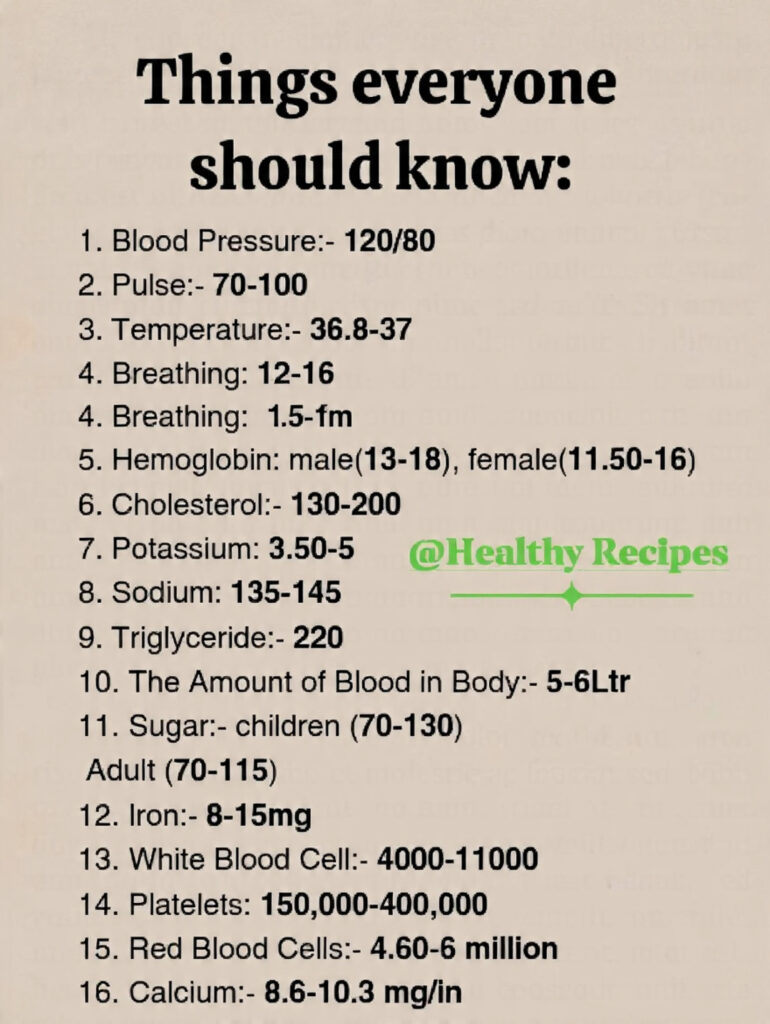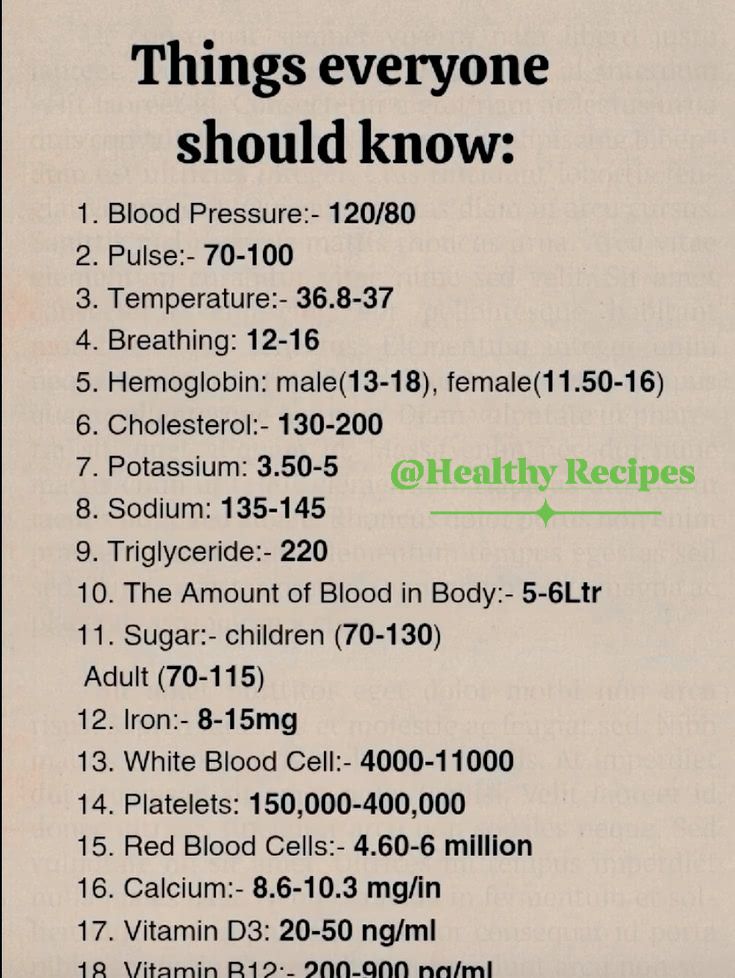
Here is a more detailed breakdown of each item, including what it means, why it’s important, and more precise standard ranges.
🔹️🔹️🔹️
Detailed Breakdown of Key Health Metrics
1️⃣ Blood Pressure: 120/80 mmHg
▪️ What it is: The pressure of blood against your artery walls
▪️ The top number (systolic) is the pressure during a heartbeat
▪️ The bottom number (diastolic) is the pressure between beats.
▪️ Why it’s important: High blood pressure (hypertension) is a major risk factor for heart attack, stroke, and kidney disease.
▪️ More Detail:
▪️ Normal: Less than 120/80 mmHg
▪️ Elevated: 120-129 / Less than 80 mmHg
▪️ Hypertension Stage 1: 130-139 / 80-89 mmHg
▪️ Hypertension Stage 2: 140 or higher / 90 or higher
2️⃣ Pulse (Heart Rate): 70-100 beats per minute (bpm)
▪️ What it is: The number of times your heart beats per minute.
▪️ Why it’s important: Can indicate fitness level, stress, dehydration, or heart conditions.
▪️ More Detail: · A normal resting heart rate for adults is more accurately 60-100 bpm. Well-trained athletes can have a resting heart rate as low as 40-60 bpm.
3️⃣ Temperature: 36.8-37°C (98.2-98.6°F)
▪️ What it is: A measure of your body’s internal heat.
▪️ Why it’s important: Fever (pyrexia) can indicate infection or inflammation.
▪️ More Detail: Normal body temperature can vary throughout the day and based on the measurement site (oral, rectal, ear, forehead). A fever is generally considered 38°C (100.4°F) or higher.
4️⃣ Breathing (Respiratory Rate): 12-16 breaths per minute
▪️ What it is: The number of breaths you take per minute.
▪️ Why it’s important: A high or low respiratory rate can signal problems with the lungs, heart, or metabolic system.

5️⃣ Hemoglobin (Hb)
▪️ What it is: The iron-rich protein in red blood cells that carries oxygen.
▪️ Why it’s important: Low levels indicate anemia, which causes fatigue and weakness. High levels can be due to dehydration or other conditions.
▪️ More Detail (in g/dL):
▫️ Male: 13.5 – 17.5 g/dL
▫️ Female: 12.0 – 15.5 g/dL
6️⃣ Cholesterol: 130-200 mg/dL
▪️ What it is: A waxy substance made by the liver and obtained from food. It’s vital for building cells, but too much “bad” cholesterol is dangerous.
▪️ Why it’s important: High cholesterol builds up in arteries, increasing heart attack and stroke risk.
▪️ More Detail: It’s crucial to look at the components:
▫️ Total Cholesterol: Desirable is <200 mg/dL.
▫️ LDL (“Bad”) Cholesterol: Optimal is <100 mg/dL.
▫️ HDL (“Good”) Cholesterol: Protective; optimal is >60 mg/dL. · Triglycerides: (See point 9).
7️⃣ Potassium: 3.5-5.0 mmol/L
▪️ What it is: An essential mineral (electrolyte) for nerve function and muscle control, including the heart muscle.
▪️ Why it’s important: Levels that are too high (hyperkalemia) or too low (hypokalemia) can cause dangerous heart arrhythmias.
8️⃣ Sodium: 135-145 mmol/L
▪️ What it is: A vital electrolyte that regulates fluid balance in and around your cells.
▪️ Why it’s important: Imbalances can cause confusion, weakness, seizures, and coma.
9️⃣ Triglycerides: <150 mg/dL
▪️ What it is: The most common type of fat in your body, storing excess energy from your diet.
▪️ Why it’s important: High levels are linked to hardened arteries and pancreatic inflammation.
▪️ Correction: The value of 220 mg/dL on your list is too high and is considered in the “High” risk category.
▫️ Normal: Less than 150 mg/dL
▫️ Borderline High: 150-199 mg/dL
▫️ High: 200-499 mg/dL
▫️ Very High: 500 mg/dL and above
🔟 Blood Volume: 5-6 Liters
▪️ What it is: The total amount of blood in the circulatory system.
▪️ Why it’s important: This is an average. It’s about 7-8% of an adult’s body weight. Loss of a significant volume (hemorrhage) is life-threatening.

Leave a Reply